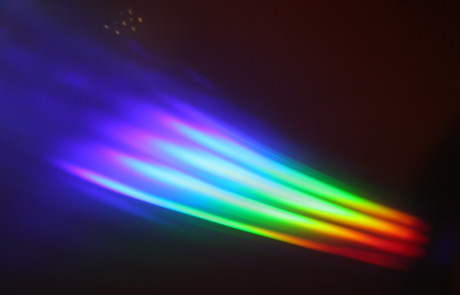Breaking the colour barrier: microscopy in biology

Researchers from Columbia University are one step closer to breaking the so-called ‘colour barrier’ of light microscopy for biological systems, allowing for more comprehensive labelling and imaging of biomolecules in living cells and tissues than is currently attainable. Their work has been published in the journal Nature.
All existing methods of observing a variety of structures in living cells and tissues are currently hindered by fundamental limitations, not the least of which is the existence of a colour barrier. Fluorescence microscopy, for example, is used prevalently in biology labs due to its high sensitivity, allowing scientists to monitor cellular processes in living systems by using fluorescent proteins. However, the colour barrier limits researchers to seeing a maximum of only five structures at a time, as these fluorescent proteins emit a range of shades that fall into five broad colour categories.
So what does this mean for a researcher who is trying to observe all the hundreds of structures and different cell types in a live brain tumour tissue sample? Well, they would be restricted to seeing only up to five structures at a time on a single tissue sample — if they wanted to see more, they would have to clean the tissue of the fluorescent labels used to identify those five structures in order to use those same fluorescent labels to identify another set of up to five structures. This process would have to be repeated again and again, making it extremely labour-intensive and risking the loss of vital components every time the tissue is cleaned.
“We want to see them all at the same time to see how they’re operating on their own and also how they’re interacting with each other,” said Lu Wei, a lead author on the study and a postdoctoral researcher in the lab of Associate Professor Wei Min. “There are lots of components in a biological environment and we need to be able to see everything simultaneously to truly understand the processes.”
Unlike fluorescence microscopy, Raman microscopy observes living cell and tissue structures by making visible the vibrations stemming from characteristic chemical bonds in structures. As this method lacks the sensitivity of fluorescence microscopy, it requires a strong, concentrated vibrational signal that can only be achieved through the presence of millions of structures with the same chemical bond. If the signal from the chemical bonds is not strong enough, visualising the associated structure is near impossible.
To address this challenge, Min and his team pursued a novel hybrid of existing microscopy techniques. They eventually developed a platform called electronic pre-resonance stimulated Raman scattering (epr-SRS) microscopy that combines the best of both worlds, bringing together a high level of sensitivity and selectivity.
The new technique identifies, with extreme specificity, structures with significantly lower concentration. Instead of millions of the same structure needed to identify the presence of that structure in traditional Raman microscopy, the new instrument requires only 30 for identification.
The researchers also designed a set of tagging molecules to work synergistically with the technology. The amplified colour palette of molecules broadens tagging capabilities, allowing for the imaging of up to 24 structures at a time, rather than five. The researchers believe there is potential for even further expansion in the future.
The team has already tested the epr-SRS platform in brain tissue, with Wei saying the larger colour palette enabled the researchers to see different cells working together.
“We can now light up all these different structures in brain tissue simultaneously. In the future, we hope to watch them function in real time,” she said, adding that the technique could be used for imaging structures other than brain tissue.
“Different cell types have different functions, and scientists usually study only one cell type at a time. With more colours, we can now start to study multiple cells simultaneously to observe how they interact and function both on their own and together in healthy conditions versus in disease states.”
The platform has many potential applications, said Min, including helping to guide the development of therapies to treat and cure disease — perhaps even treating tumours that are hard to kill with currently available drugs.
“If we can see how structures are interacting in cancer cells, we can identify ways to target specific structures more precisely,” he said, adding that the technique could be ‘game changing’ in the pursuit of understanding anything that has a lot of components.
“Our platform has the capacity to transform understanding of complex biological systems: the vast human cell map, metabolic pathways, the functions of various structures within the brain, the internal environment of tumours and macromolecule assembly, to name just a few,” he said.
MRI scanner to advance medical breakthroughs at Monash
Siemens Healthineers' MAGNETOM Cima.X 3T is claimed to be Victoria's most advanced,...
Virtual pathology streamlines rapid onsite evaluation
Technology from Grundium, a specialist in digital imaging for pathology, has been shown to match...
Cannabis detected in breath from edibles
Researchers say they have made the first measurement of THC in breath from edible cannabis, in a...



